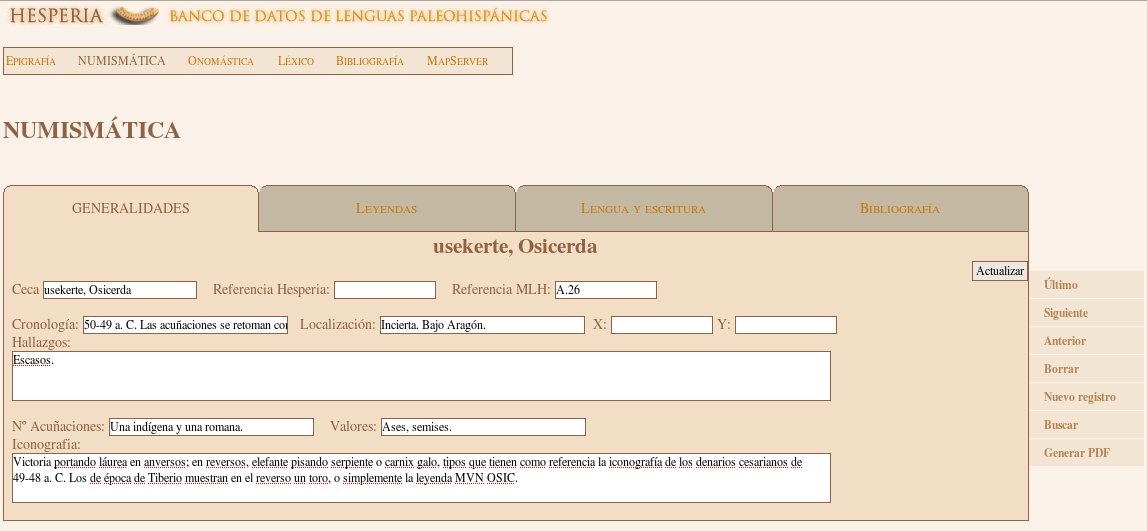Numismatics
An external view of a numismatic page (click to enlarge):

The numismatics section of the HESPERIA Palaeohispanic Languages Database contains every Palaeohispanic coin legend from mints in Hispania and south-western Gaul, mainly in the Iberian and Celtiberian languages, without discounting the possibility that some of the mints in the north-western Ebro Valley used the Vasconic language.
The so-called "Lybio-Phoenician" coins have been excluded, since neither their alphabet nor their script have been accurately determined, as well as Punic, Latin and Greek coin legends, except in the case of Greek and Latin when they are used in combination with a Palaeohispanic language on bilingual and mixed coins.
Every record of the numismatic section of HESPERIA corresponds to a single mint, unlike the epigraphic section where every page is devoted to one inscription. Each record is named after the most common toponym of the mint, regardless of its morphology (for example untikesken, salduie, kalakorikos, turiazu, etc.) and contains every Palaeohispanic legend issued from this mint.
Through the search function it is possible to quickly find words or complete coin legends (and also other non-epigraphic information about the coins) and, in the record itself, find information on context, images, and a bibliography on the mint.
Every record has four tabs: "Generalidades" (= general features), "Leyendas" (= coin legends), "Lengua y escritura" (= language and script and "Bibliografía" (= bibliography).
1.Generalidades. The "General Features" tab is headed by the name of the mint and the reference numbers, both of MLH and HESPERIA. The HESPERIA reference consists of the abbreviation of "moneda" ("coin"), "Mon.", followed by a correlative number, which is frequently the same as that of MLH, which is made up of the letter A followed by a number (1 – 103). For example, kelse is Mon.21 (= MLH A.21).
Numbers 104 onwards have been assigned:
- a) to mints identified after the publication of MLH (for example, labini, Mon.111); mints that had an anomalous record number in MLH (for example, bikanaos A.29A = Mon.104); pairs of mints that have been mistakenly put under the same record number in MLH (Contrebia Belaisca / Contrebia Carbica A.75 = Mon.75 and Mon.105, respectively).
- b) The coin legends of the imitations of the drachmas from Emporion, whether legible (Mon.109) or not (Mon.110); the legends of the lead coins (Mon.115, Mon.116) and some suspicious ones (Mon.106, Mon.107 and Mon.112, whose record number is labelled with the caution "SUSPECTA" ).
On the same page, background information about the mint can be found: chronology, location, geographic dispersion of finds, number of series minted, denominations and iconography.
2.Leyendas. The "Coin legends" tab includes every legend inscribed in production of this mint, including non-Palaeohispanic legends in the case of bilingual coins, with a separate entry for each different coin legend, with legend taken to mean both texts that appear on the obverse and reverse together. The transcriptions of the text follow the most popular systems among researchers. For the Iberian mints and those in the north-eastern Ebro Valley the system of transcription used in the MLH has been followed, while for Celtiberian, the system of transcription proposed by F. Villar (1995) is preferred (See Scripts)
A link next to each legend opens a new window containing further information about that text: chronology, critical apparatus, identification of the legend, main bibliographical references, minor legends and iconography, denominations, and images available.
3. Lengua y Escritura. The "Language and script" tab offers the most relevant palaeographic and linguistic features of each mint.
4.Bibliografía. The "Bibliography" tab shows the abbreviations of the main bibliographical references for each mint. The links on the right of the page allow the user to browse the database or search for mints and legends (by pressing the button marked "leyendas/legends")
The contents of the numismatic database, including images, constitute the second volume of HESPERIA Palaeohispanic Database, available at the publishing services of the University of the Basque Country (UPV/EHU).
© 2005 Departamento de Filología Griega y Lingüística Indoeuropea · Universidad Complutense de Madrid
License Data Bank last update: 2026-01-06 19:25:41